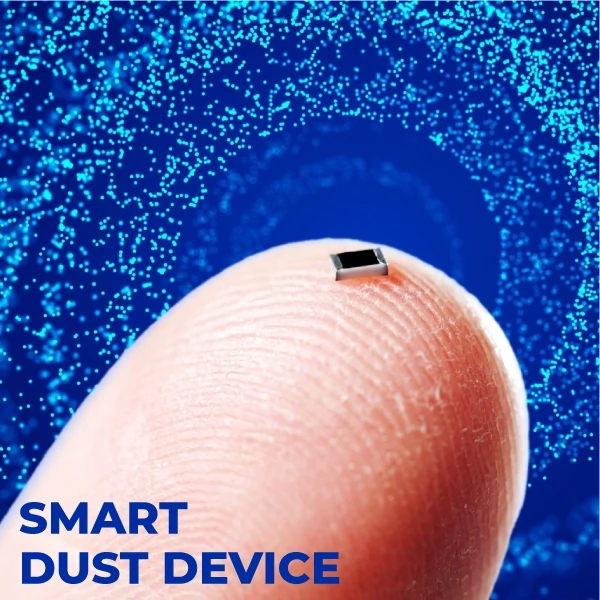Summary of blog
Smart dust is a tiny sensor that measures temperature, sound, and humidity. It is like a mini-computer that can send this information wirelessly to other computers. This technology is still being developed but could be used in many different ways, such as monitoring crops, tracking machinery, and checking the environment for safety. However, smart dust also comes with potential drawbacks. Imagine tiny sensors scattered across a field, constantly monitoring the health of crops. Farmers could use this data to optimize watering, fertilization, and pest control, ultimately improving crop yield and quality. In an industrial setting, smart dust could be deployed to track machinery and identify potential problems before they cause costly breakdowns. Even environmental monitoring for safety purposes could benefit from these miniature sensors. Privacy concerns arise due to the sensors’ ability to detect subtle changes in their surroundings. Additionally, the widespread use of smart dust raises questions about control and potential cyberattack vulnerabilities. Security systems would need to be robust to prevent misuse of this technology.
What is a smart dust device?
Consider a cloud of sensors, each the size of a grain of sand or smaller, being carried upwards by hurricane winds and transmitting storm data to meteorological stations. With evolving technology, we might imagine a day in which wireless devices as small as a dust particle or even smaller than the eye of a needle may collect data and send it back to a base for processing. Consider a world where you are surrounded by thousands of tiny robots who track every movement you make. Smart Dust technology makes this dream a reality.
Let me explain a bit more about smart dust; let’s get started. The term “smart dust” refers to internet-connected dust particles. Okay, not quite. They are dust particle-sized sensors that measure about one millimeter. They can monitor and sense various environmental signals, including sound, temperature, and humidity. These sensors are wirelessly connected to a network and function as sensors in an IoT system. In this article, I will take you through the journey of smart dust devices, with their working principle, components, applications, and pros and cons including how AI-powered dust control systems integrate seamlessly with these technologies.
Working principle of smart dust device
Smart dust functions similarly to other sensors used in IoT systems, except that these systems are significantly smaller in size and far more numerous. They are connected to a network and send data across short distances. Since we are dealing with sensor-based technology, and I have an environmental engineering background. Let me give you a technical definition for it. Smart dust networks contain nodes (called ‘mote’) that combine sensing, computing, wireless communication capabilities, and autonomous power supply in a tiny package with a volume of a few cubic millimeters or even less.
As you might expect, making them small is the biggest technological challenge. For this reason, they are typically 3D printed. Making a small enough power supply is more challenging than making the sensor small. To accomplish this, researchers have used strategies such as using power generation equipment such as solar panels or vibration motors to generate power rather than store it. Another technique for running the device with little power consumption is to let it sleep most of the time and only wake it up to collect and transmit data.

Component of smart dust device

Every mote comprises four types of equipment: sensors, circuits, communication, and power supplies. The complete package includes one or more MEMS ( microelectromechanical systems) or NEMS (nanoelectromechanical systems) sensors that detect and measure vibration, temperature, pressure, sound, light, magnetic field, and other parameters. Circuits (microcontrollers) interface with sensors and process and store data.
Communication ideally includes a transmitter and a 3D antenna that assures equal radiation in all directions, allowing for orientation-insensitive communication. Depending on the area of operation, the mote’s power supply could be a solar cell array, a thin-film battery, or a supercapacitor.
Application of smart dust device (Practical Application)

The broad range of smart dust applications makes thorough descriptions impossible in a single article. So, I will just list some significant areas below.
- Agriculture: Constant monitoring of a crop’s nutritional needs, including watering, fertilization, and insect management. This vital information can help improve crop yield and quality. Smart dust can potentially transform the way IoT and AI are used in agriculture. Most AI systems rely on computer vision to detect pests and illnesses. Robots that pluck fruits use cameras to identify them and determine whether they are ripe enough. While these technologies automate much of the work in agriculture, they are not considerably better than humans at detecting diseases or ripeness.
- Industrial: Another application for smart dust could be monitoring industrial processes or industrial dust, which manufacturers produce. However, monitoring with dustroid dust monitoring system , which is MCERTS certified and provides real-time accurate data, can effectively manage dust and make informed decisions based on the monitoring. Large-scale sensor deployments can identify cracks in machinery or tank leaks long before they are detected or begin to influence performance.
- Environment: Chemical and biological environmental monitoring for health and safety reasons (water, air, and soil).
- Urban infrastructure: Monitoring will include buildings, roads, bridges, tunnels, water and sewer pipelines, and electrical and telecommunications networks as part of a smart city’s overall concept.
Smart dust technology
You might be wondering that I have explained what smart dust is, how it works, and its applications. However, you might be thinking about the smart dust concept invention, right? Don’t worry. I am here to tell you everything regarding smart dust. Let me tell you who invented the smart dust technology.

Pister imagined a world where sensors could measure almost everything. He thought about how this could help with things like tracking the weather. You can read more about his ideas in his 2000 paper, “Emerging Challenges: Mobile Networking for ‘Smart Dust’.” However, it isn’t surprising that the military motivated and provided financing to develop smart dust. In 1992, DARPA funded Pister’s research in the Smart Dust project.
MEMS sensors
MEMS is an acronym for microelectromechanical systems, which are exceptionally small devices that incorporate mechanical, electrical, and frequently optical components on a single microchip. Despite their micro scale, these devices perform various functions, from sensing and actuating to data processing and communication. MEMS technology has redefined modern technology, improving performance and innovative applications across diverse industries.
MEMS are mechanical sensors and actuators that are fabricated using micromachining batch technologies similar to those used for integrated circuits. This translates into highly scalable production processes and low per-device production costs. MEMS have feature sizes ranging from micrometers to millimeters. To see how small that is, consider that a regular sheet of paper is between 70 and 180 micrometers thick.
Advantages and disadvantages of smart dust device
- Improve productivity: Monitor, regulate, and manage many processes in any workplace. Workplaces might include factories, office buildings, and agricultural lands. To identify and eliminate wasteful activities to improve employee efficiency. Discover actionable insights to streamline procedures.
- Enhance security: Once implemented, it can benefit enterprises in many ways. It has the potential to significantly improve commercial security frameworks, intruder detection, non-surveillance floor sensors, perimeter security, and other aspects. Collect and analyze data on heartbeat, breathing, emotions, attitudes, and so on using wearable sensor-based devices, voice recognition to determine intoxication levels, and lie detection features.
- Reduce infrastructure costs: Implement Smart Dust solutions to save money and reduce downtime. For example, identify machine failures ahead of time, turn street lights on when people approach them, activate the elevator button as you enter the building, and monitor and receive notifications on plant health. These small robots are less expensive and easier to reinstall when the environment changes.
Smart Dust offers a variety of advantages. However, there are some drawbacks. Although the downsides appear to be slight in comparison to their positives. Nonetheless, they should be considered. They are:
- Privacy Issue: One of the biggest drawbacks of Smart Dust is the privacy concern for companies that use it. Smart Dust detects even the subtlest changes, leaving little to the imagination. It is a tiny sensor that can record anything you want it to. Because this new technology is so small, people are concerned that companies may spy on it.
- Control: Once Smart Dust sensors are installed worldwide, it may be impossible to catch them without being aware of their presence. Alternatively, they may lose connection or malfunction. Strict geological systems exist to control and prevent any potentially dangerous use.
- Cybersecurity: Cyber-attacks are constantly among the top new headlines worldwide, and Smart Dust is vulnerable to illegal acts by hackers. Systems require consistent threat prevention, vulnerability assessment, and software patches.
Conclusion
Finally, smart dust devices represent a revolutionary advancement in sensor technology, offering unprecedented capabilities for monitoring and collecting environmental data. With their compact size and wireless connectivity, they have the potential to revolutionize various industries, from environmental monitoring to healthcare and beyond. It is creating a new era of interconnected and data-driven systems.
Smart dust can be used for environmental monitoring, industrial sensing, healthcare, infrastructure monitoring, and military surveillance.
Smart dust gathers data on air quality, temperature, humidity, and pollution levels to monitor environmental changes and assess risks.
Costs vary based on sensor complexity, deployment scale, and project needs, but smart dust is generally designed to be cost-effective for large-scale use.






